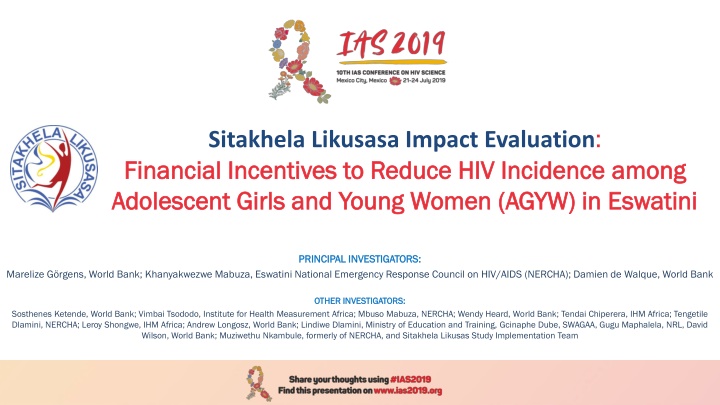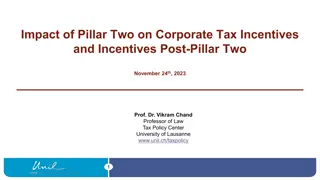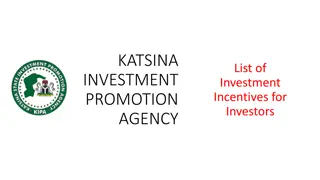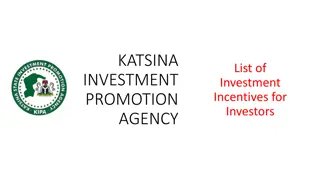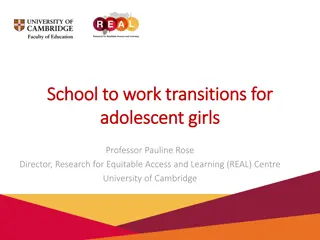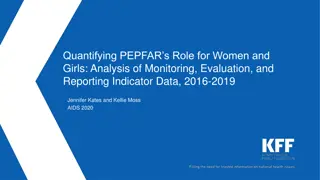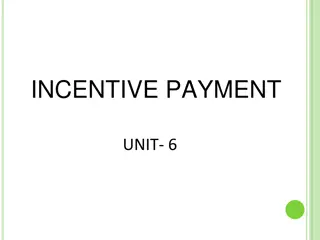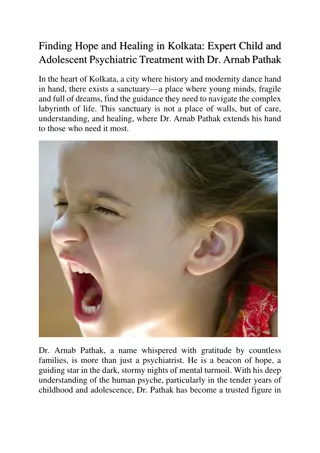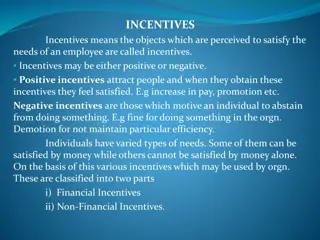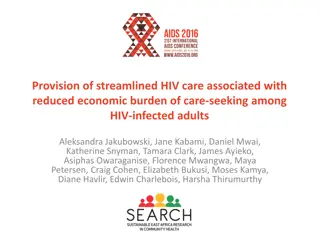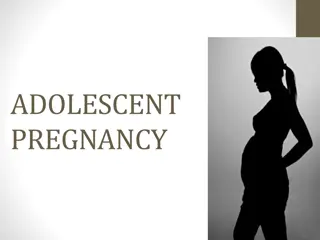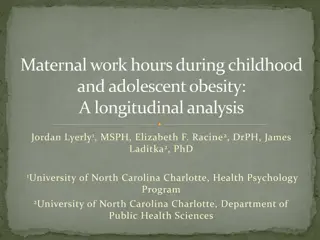Financial Incentives to Reduce HIV Incidence among Adolescent Girls and Young Women in Eswatini
Impact evaluation study focusing on implementing financial incentives to address multiple vulnerabilities faced by adolescent girls and young women in Eswatini, aiming to reduce high-risk sexual behaviors. The study involves principal and other investigators working with various study partners to gather data and implement interventions.
Uploaded on Feb 27, 2025 | 2 Views
Download Presentation

Please find below an Image/Link to download the presentation.
The content on the website is provided AS IS for your information and personal use only. It may not be sold, licensed, or shared on other websites without obtaining consent from the author.If you encounter any issues during the download, it is possible that the publisher has removed the file from their server.
You are allowed to download the files provided on this website for personal or commercial use, subject to the condition that they are used lawfully. All files are the property of their respective owners.
The content on the website is provided AS IS for your information and personal use only. It may not be sold, licensed, or shared on other websites without obtaining consent from the author.
E N D
Presentation Transcript
Sitakhela Likusasa Impact Evaluation: Financial Incentives to Reduce HIV Incidence Financial Incentives to Reduce HIV Incidence among Adolescent Girls and Young Women (AGYW) in Eswatini Adolescent Girls and Young Women (AGYW) in Eswatini among PRINCIPAL INVESTIGATORS: PRINCIPAL INVESTIGATORS: Marelize G rgens, World Bank; Khanyakwezwe Mabuza, Eswatini National Emergency Response Council on HIV/AIDS (NERCHA); Damien de Walque, World Bank OTHER INVESTIGATORS: OTHER INVESTIGATORS: Sosthenes Ketende, World Bank; Vimbai Tsododo, Institute for Health Measurement Africa; Mbuso Mabuza, NERCHA; Wendy Heard, World Bank; Tendai Chiperera, IHM Africa; Tengetile Dlamini, NERCHA; Leroy Shongwe, IHM Africa; Andrew Longosz, World Bank; Lindiwe Dlamini, Ministry of Education and Training, Gcinaphe Dube, SWAGAA, Gugu Maphalela, NRL, David Wilson, World Bank; Muziwethu Nkambule, formerly of NERCHA, and Sitakhela Likusas Study Implementation Team
Study Partners MINISTRY OF HEALTH MINISTRY OF EDUCATION AND TRAINING KINGDOM OF ESWATINI National Reference Laboratory, and Swaziland National AIDS Programme (SNAP) KINGDOM OF ESWATINI For baseline survey Main study implementation partner SGBV counselling and follow up For baseline survey
Multiple Vulnerabilities of AGYW in Eswatini Multiple Vulnerabilities of AGYW in Eswatini Only 33% female enrolment in secondary school Rape and gender-based Low negotiating power support and services Limited access to Early sexual debut Multiple partners School dropout Late marriage violence Low rates of return after school dropout High youth unemployment and only 40% female participation in labour market High and increasing levels of transactional sex Sex with older partners Commercial sex work economic stressors Teen Pregnancy Transactional sex Low social status Poverty, Socio- % women aged 15-24 in Eswatini who had sex in the last 12 months with a partner who was 10 or more years older 15% 14% 7% High risk sexual behavior cycle because of multiple vulnerability to HIV 2014 2007 2010 Source: DHIS 2007, MICS 2010, and MICS 2014 Growing evidence that financial incentives could reduce economic drivers for high-risk sexual behaviour
First, Mathematical Modelling: First, Mathematical Modelling: Potential Future Impact of 5 Core Interventions on HIV incidence and AIDS deaths in Eswatini 100% TB/HIV 36% 80% 14% PMTCT 18% 60% CCT Cash Transfers 49% 40% VMMC 57% 20% ART 27% 0% Percent contribution to new HIV infections averted Percent contribution to AIDS-related deaths averted Source: World Bank and Burnet Institute, 2014
Two kinds of Interventions Two kinds of Interventions Implemented in School Years 2016, 2017 and Years 2016, 2017 and 2018 Implemented in School 2018 1. EDUCATION INCENTIVES definite incentive, if condition (education) met Incentives paid for enrolling in and attending school (E1400 (~$100) per year) Incentives paid for enrolling in and completing other education like tertiary education, upgrading or short courses (E1400 (~$100) per year) Only in 2018, tuitionfees paid for out of school participants (up to E2900 (~$200) per course) 2. RAFFLES possibility of incentive, if condition (no STIs) met 50% of participants also eligible for raffle. 7 raffles held: In each raffle round, 400 participants randomly selected for STI testing If negative for syphilis and trichomonas vaginalis, then eligible for raffle prize 80 raffle winners drawn every round, 560 raffle winners in total Raffle prize money per round: E1000 (~$72)
Geographic distribution of participants at baseline and endline Study Population Study Population From Nov 2015 March 2016, enrolled 4389 adolescent girls and young women (AGYW) aged 15-22 in Eswatini from 266 enumerator areas Stratified enrolment: 50% in school or other form of education and 50% out of school or other education 80% from rural enumeration areas and 20% from urban enumeration areas
Design and Intervention Arms 2x2 factorial design 4 study sub-arms
How study population was allocated to 4 sub How study population was allocated to 4 sub- -arms arms
Timeline Timeline
Intervention Intervention Coverage Summary Coverage Summary 1. EDUCATION INCENTIVES 59% Incentives paid for enrolling in and attending school (E1400 (~$100) per year) Incentives paid for enrolling in and completing other education like tertiary education, upgrading or short courses (E1400 (~$100) per year) 31% Only in 2018, tuitionfees paid for participants who were out of school at midline (up to E2900 (~$200) per course) 2. RAFFLES 19% received prizes ~2200 participants (50%) also eligible for raffle. 7 raffles held: In each raffle round, 400 participants randomly selected for STI testing If negative for syphilis and trichomonas vaginalis, then eligible for raffle prize 80 raffle winners drawn every round, 560 raffle winners in total (470 individual winners) Raffle prize money per round: E1000 (~$72)
Participation in study endline data collection Participation in study endline data collection Arm of the study Education Treatment Arm Response Rate at endline 87% Education Control Arm 85% Overall Response Rate 86% Response rate of 86% at endline > 19% LTFU anticipated at sample design stage
Non Non- -response at endline was not significantly response at endline was not significantly associated with study sub associated with study sub- -arm arm Participated at endline Did not participate at endline P-value No intervention sub-arm 85.1% 14.9% Raffle sub-arm 85.6% 14.4% 0.374 Education incentive only sub-arm 87.0% 13.0% Education incentive and Raffle sub- arm 87.3% 12.7%
Evaluation Question 1: Evaluation Question 1: Did the education incentives have an Did the education incentives have an impact on new HIV infections? impact on new HIV infections? YES, a significant impact (Adjusted for raffle incentive) P- P- Odds Ratio [95% Confidence Interval] HIV incidence value value Education Control Arm 8.08% 1 0.036 0.037 Education Treatment Arm 6.34% 0 .77 [0.60- 0.98] Total 7.21% HIV incidence in the education incentive treatment arm was 21% lower than in the education incentive control arm Participants in the education incentive treatment arm were 23% less likely to become HIV positive
What put participants at risk of getting HIV? What put participants at risk of getting HIV? Profile of participant Being out of school Risk-loving participants At education level years 1-5 Richest 20% of participants At education level Forms 1-6 29% less likely to have acquired HIV How likely to have acquired HIV 190% more likely to have acquired HIV 145% more likely to acquire HIV 56% less likely to have acquired HIV 35% less likely to acquire HIV Risk-loving participants: during surveys, played a game with participants to assess their propensity to take risk when it comes to financial decision making. Based on how they responded, participants were classified on a scale ranging from risk averse to risk loving.
Treatment on the Treated Analysis Treatment on the Treated Analysis 12 Raffle and Education incentive including tuition fee payments HIV incidence over study period (%) 10 HIV incidence trends (moving average) amongst those in education treatment arm, by number of incentive payments received (P = 0.003) Trendline (moving average) for raffle and education incentives, including tuition 2 per. Mov. Avg. (Raffle and Education incentive including tuition fee payments) fee payments 8 6 4 2 0 0 2 4 6 8 10 12 Number of incentive payments (raffles, education incentives and tuition fee payments)
Treatment on the Treated Analysis: Instrumental Variable Treatment on the Treated Analysis: Instrumental Variable Probit Probit Model Results Model Results Instrumented by Education Treatment Arm allocation: There was a marginal effect of additional payments for each additional round of education incentive received, HIV incidence was reduced by 3.9 percentage points (p=0.014) Also, the TOT risk factor analysis confirmed the ITT risk factor analysis outcomes: Participants with higher levels of education were less likely to acquire HIV infection Risk-loving participants were 18% more likely to acquire HIV confirming the ITT correlate analysis (p=0.031)
Self Self- -reported education attendance at endline reported education attendance at endline Not enrolled in school Enrolled in school P-value Education incentive treatment arm 45.3% 54.7% <0.001 Education incentive control arm 54.4% 45.6%
Evaluation Question 2: Evaluation Question 2: Did the raffle an impact on new HIV infections? an impact on new HIV infections? Did the raffle on its own on its own have have NO, not significant impact Arm HIV Incidence over the study period 7.83% P-value Odds Ratio [95% confidence interval] 1 0.833 [0.648 -1.070] P-value Raffle Control Arm Raffle Treatment Arm 0.133 0.152 6.61%
Evaluation Question 3: Evaluation Question 3: Did the raffle amplify the impact on HIV incidence? Did the raffle amplify the impact on HIV incidence? YES, together, the biggest impact Odds Ratio HIV Incidence over the study period P-value [95% confidence interval] No intervention 1 8.84% Raffle only 0.82 [0.59, 1.14] 0.245 7.38% Education only 0.76 [0.54, 1.07] 0.116 6.87% Education and Raffle 0.63 [0.44, 0.91] 0.013 5.79% 35% difference in HIV incidence between no intervention sub-arm and the raffle and education sub-arm Participants in the raffle and incentive sub-arm compared to no intervention arm were 37% less likely to have acquired HIV
Next Steps Next Steps Additional quantitative analysis focusing on secondary research questions Expand treatment-on-the-treated analyses Conduct benefit-cost analysis Conclude qualitative research Academic publication and national dissemination
